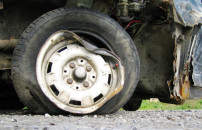After successful rescue, 3rd C Buddhist figures destroyed at police station
The artefacts were stolen from Taxila, Peshawar, Swat and Afghanistan.

After successful rescue, 3rd C Buddhist figures destroyed at police station
Amid the sweating and heaving, labourers offloading smuggled boxes from a seized container argued whether their contents were Hindu or Buddhist, ignoring that they were smashing the treasures in the process.
The work, which began at about 8am turned the Awami Colony police station into a mangled museum of Gandhara art of over 30 pieces. “We’ll open a museum right here,” joked one of the police officers. “Here, you want to take one home?” Their value in Japan, according to one estimate, could be more than $10 million.
The truck carrying the sculptures was seized by the police at Bilal Chowrangi in Korangi. Its other contents included water coolers, slippers, straw and broom sticks. “We got a tipoff from the intelligence agencies and seized the truck,” beamed SHO Javed Brohi. The artefacts, sculptures, tablets, and figures were destined for Sialkot. The driver, Zafar Ali, was arrested but all he could tell the police was that the vehicle was loaded from his employer Asif Butt’s warehouse in Ibrahim Haidery.
Butt, who owns the container (JT 8988), told The Express Tribune that the consignment was loaded late at night from a warehouse in Korangi Industrial Area. “The consignment initially consisted of water coolers, shoes and broom sticks belonging to three separate companies,” he said. “But at night, a fourth party approached us and told us to load their things and supply them to Sialkot.” Butt denied that he knew what was inside the five big and eight small boxes but has said he will cooperate with the police to give them the details of the man who gave him the boxes.
The figures were wrapped in colourful foam and placed in wooden boxes. But as the police and labourers had no idea of the value of the artefacts they were dumped in the courtyard of the police station. Many were simply smashed, some ended up headless and others lost their hands and feet.
The artefacts
According to Qasim Ali Qasim, the director of the archaeology and museums department, the Buddhist sculptures were known as Gandhara art and were found in Taxila, Peshawar and Swat in Pakistan and even parts of Afghanistan.
He estimated that they date to the third century and are mostly of mediating goddesses and gods. One of the heaviest ones was a 1,000 kg Bodhisattva, a mustached sculpture, adorned with a crown and ornaments. In Buddhism, a Bodhisattva is an enlightened and wise being who invites others towards Buddhism.
Pointing to a tablet with dancing goddesses engraved on it, Qasim explained that it was an important artefact known as Jataka. “This piece tells the story of Gautama Buddha’s birth,” he said. “Though images, it shows how Queen Maya gave birth to him and shows others dancing and pouring water in joy.”
Another prominent sculpture was Hariti, a mother goddess with one child in her arms and the other standing next to her. “This goddess was a demon and used to eat children, but after meeting Buddha, she became a mother goddess.”
Qasim doubted that the artefacts were stolen from a museum or their reserves, and said they were most likely illegally dug up from Swat during the presence of the Taliban in the valley. This would have been a violation of the Antiquities Act of 1975, he added, saying that you needed a licence to be in possession of such items.
Published in The Express Tribune, July 7th, 2012.


















COMMENTS
Comments are moderated and generally will be posted if they are on-topic and not abusive.
For more information, please see our Comments FAQ